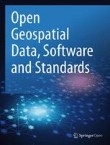Open geospatial data and tools are an increasingly important paradigm that offers the opportunity to promote the democratization of geographical information, the transparency of governments and institutions, as well as social, economic and environmental opportunities. During the past decade, developments in the area of open geospatial data and open source geospatial software have greatly increased. The Open Source GIS research community believes that combining free and open software, open data, as well as open standards, leads to the creation of a sustainable ecosystem for accelerating new discoveries to help solve global cross-disciplinary societal challenges, from climate change mitigation to sustainable cities.
We invite original research contributions on all aspects of open source geospatial software and its applications, and particularly encourage submissions focusing on the following themes for this Special Issue.
● The use of open source geospatial data, software and standards in scientific research
● Architectures and frameworks for open source software and data
● Quality of open data
● Volunteered Geographic Information and Public Participatory GIS
● Human computer interfaces and usability in and around open GI systems
● Big data
● Open source GIS service/software implementations
● Teaching geospatial sciences with open source solutions and open data
● Applied applications in different use cases, e.g. government, health, climate change, energy, water, urban studies, location based services, etc.
Guest Editors:
Francesco Pirotti, University of Padova, Italy (francesco.pirotti@unipd.it)
Giorgio Agugiaro, Austrian Institute of Technology, Austria (giorgio.agugiaro@ait.ac.at)
Amin Mobasheri, Heidelberg University, Germany (a.mobasheri@uni-heidelberg.de)
